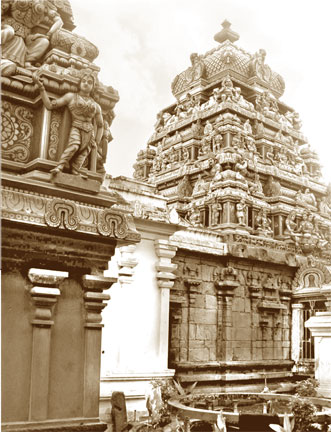Historic Munneswaram temple Chariot festival begins today
by Chelvatamby MANICCAVASAGAR
The annual festival of the ancient and historic Munneswaram Shivan
Temples Chariot festival will be held today. The temple dedicated to
Lord Shiva is situated at the fishing town of Chilaw.
Munneswaram temple along with Koneswaram (Trincomalee) Naguleswaram
(Keerimalai), Thiruketheeswaram (Mannar) and Rameswaram (South India)
form the five Ishwarams, are very popular Shivan temples in Sri Lanka.
 |
|
A view of the
Munneswaram temple |
Lord Shiva occupies the supreme place in the Saiva school of
Hinduism. Shiva worship can be traced to the beginning of history. In
the Sangam literature, the earliest collections of Tamil Literature,
there are references to Lord Shiva.
The greater interpreters of the cosmic dance of Lord Shiva, Dr.
Ananda Coomaraswamy makes the following Observations. "Lord Shiva's five
activities called "Panchakritiyas" namely Shristi (Creation), Sthithi
(Preservation), Samhara (Destruction), Anugraha (Salvation) and
Tirobhava (Illusion).
These separately considered are the activities of deities _ Brahma,
Vishnu, Rudra, Meheswara and Sathasiva.
Munneswaram temple which, revered by Buddhists and Hindus,was
completely destroyed by the Portuguese in 1578. They used crow bars to
destroy the presiding deity.
The Portuguese were able to convert 500 people from the village of
Munneswaram as Roman Catholics.
However, the locals and the temple administrators were able to hide
many of the idols of the temple complex before the destruction.
Following the destruction, the Munneswaram village came under the
control of the kingdom of Sitawaka led by King Rajasinha 1 (1581-1593),
who continuously battled with the Portuguese during his reign.
Rajasingha 1 rebuilt the temple, but due to continuous conflicts most
of the area around the temple was depopulated and cultivation of lands
was abandoned, Irrigation tanks, which provided water for cultivation
fell into disuse. The Portuguese again destroyed this temple in the
early 17th century. Kirthi Sri Rajasingha rebuilt the temple in 1790.
It was renovated in 1875 by the Untiring efforts of Cumaraswamy
Kurukal. Sinhalese make up over 78 percent of the pilgrims to Shiva and
Kali temples.
The annual Munneswaram festival attracts Hindus, Buddhists, Catholics
and even Muslims. Until the 1830s the festival lasted upon 18 days, but
since the 1960s it lasts for 28 days. On the final day of the festival
two large chariots are drawn by devotees to the Deduru Oya, for Thirthom
(Holy Bath).
After the Holy Bath the procession goes back to the temple along a
route through Chilaw accompanied by traditional Nathaswaram and
Thavilmusic. The procession passes through Kali temple before entering
the main temple.
|

